chp. 10 solar radiation
1/65
There's no tags or description
Looks like no tags are added yet.
Name | Mastery | Learn | Test | Matching | Spaced |
|---|
No study sessions yet.
66 Terms
sun composition
80% is hydrogen, 19% is helium, remaining 100 plus observed elements makeup only a tiny fraction
comprised of many layers of gases, hotter towards its center
source of sun’s energy
hydrogen to helium thermonuclear reaction (unclear what the mechanism is)
temperature on the surface of the sun
~5760K
rate of energy emission from the sun
3.8 × 10²3 kW, about 1 billionth (1.7×10^14 kW) of its energy falls on earth
important for terrestrial users of sun’s radiation:
amount of energy, spectral and temporal distribution, and its variation with time and day of the year
solar energy is
the world’s most abundant source of energy
amount is 5000x greater than sum of all other inputs
of amount of energy intercepted by earth,
30% is reflected to space, 47% converted to low temp heat and reradiated to space, and 23% powers the evaporation/precipitation cycle, less than 0.5% is represented in the kinetic energy of wind and waves and in photosynthetic storage
solar radiation on land is
about 1/3 of total (1.5×10^17), which is 6000x total energy usage in the US
70% falls on oceans
thermal radiation fundamentals
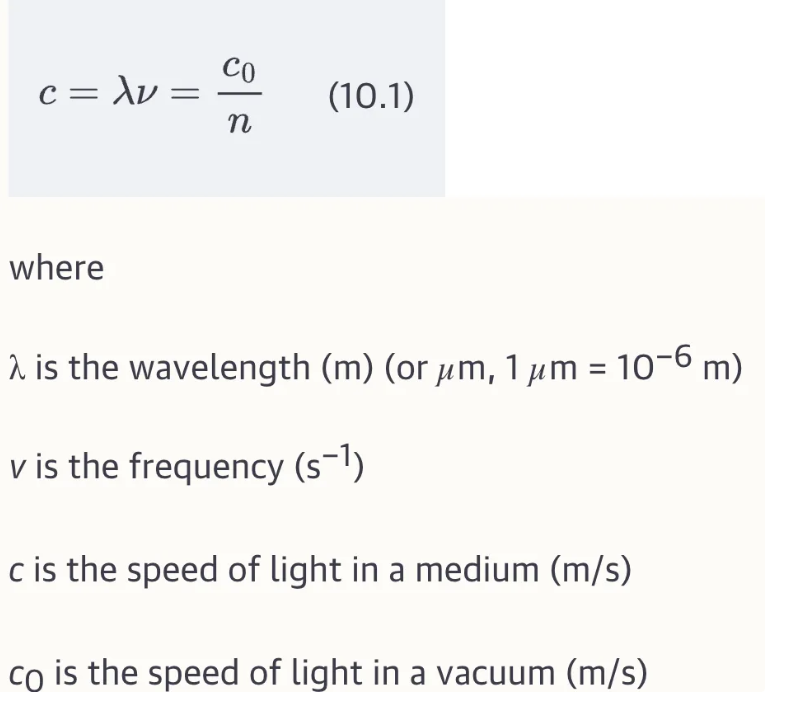
wave lengths
visible light- the rainbow

index of refraction (n)
varies with wavelength linearly because different wavelengths interfere to different extents with the atoms of the medium
blue (shorter wavelength) is slowed down more by glass than red (longer wavelength)
thermal radiation
-one kind of electromagnetic energy
-all bodies emit thermal radiation by virtue of their temp
-when a body is heated- atoms, molecules, electrons raised to higher levels of activity (excited states), but tend to return to lower energy states- this process emits energy in the form of EM waves
changes in energy states
result from rearrangements in electronic, rotational, and vibrational states of atoms and molecules
electromagnetic energy spectrum
from high energy (cosmic waves) to low energy (radio waves)
high energy has short wavelength
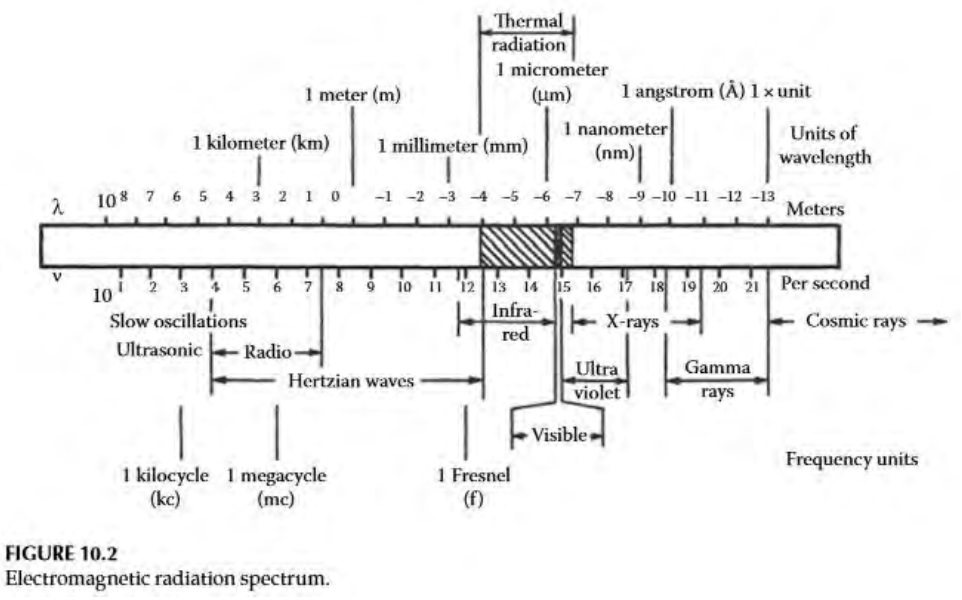
thermal radiation- 0.1-100 micrometers
solar radiation- 0.1-3 micrometers
two ways to treat electromagentic energy
waves- c= lamda(v)
particles- Ep=hvp
h- Planck’s constant (6.625 × 10^-34 Jxs)
classical wave theory
may not work for photovoltaic or photochemical processes- use view from quantum mechanics- treating EM radiation as particles
energy transported by
particles or photons (energy units)
what is an electron volt (eV)
amount of kinetic energy gained by a single electron accelerating from rest through a vacuum
1 eV- 1.602 × 10^-19 J
blue light (shorter wavelength, higher frequency) has more energy than red light (longer wavelength, lower frequency)
radiator
something that radiates energy because its hot
perfect radiator- black body
does not exist in nature, but useful in engineering because its properties can be related to those of real bodies
energy density of radiation emitted at a given wavelength
total energy emitted by a black body (Eb)
integration over all wavelengths
stefan-boltzmann law
astronomers use
color of the stars to take their temperature, use simple concepts about blackbody radiation
total energy emitted varies
as the 4th power of surface T
energy density of radiation emitted
at a given wavelength varies as T varies
as peak wavelength emitted becomes shorter as it becomes hotter, photons have more eV
beer’s law
intensity of radiation of wavelength passing through transparent medium decreases as a function of distance travelled and extinction coefficient (K lamda)
extinction coefficient (K lamda)
combines effects of absorption, emissions, and scattering caused by atoms and molecules in that medium (air, clouds, dust)
concerned with transmission of solar radiation through the atmosphere
atmosphere consists of: molecules of gases in it, N2, O2, CO2, H2O, and aerosols such as dust particles, water droplets, and ice crystals
extinction processes of the atmosphere
absorption and emission by the molecules and aerosols
scattering by the molecules
scattering by aerosols
for solar energy, we want extinction coefficent
as low as possible
incoming solar radiation can be
reflected by clouds, absorbed and scattered by the atmosphere or allowed to reach the surface
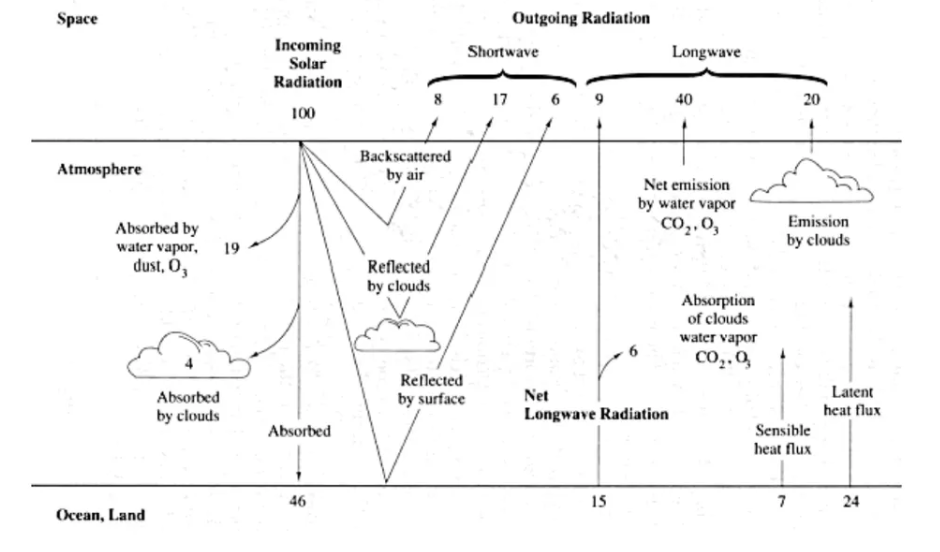
primary gases responsible for most atmospheric absorption
water vapor, carbon dioxide, ozone
clouds are the enemy of solar energy
clouds absorb and reflect incident solar radiation, impeding ability of PV cells and solar thermal mirrors to capture light and generate energy
rain might
help solar panels as it cleans the surface and cleans dust off
solar panel soiling
soiling= shading= power less
any material which blocks, scatters or reflects sunlight
solar irradiance
power per unit area received from the sun in the form of electromagnetic radiation
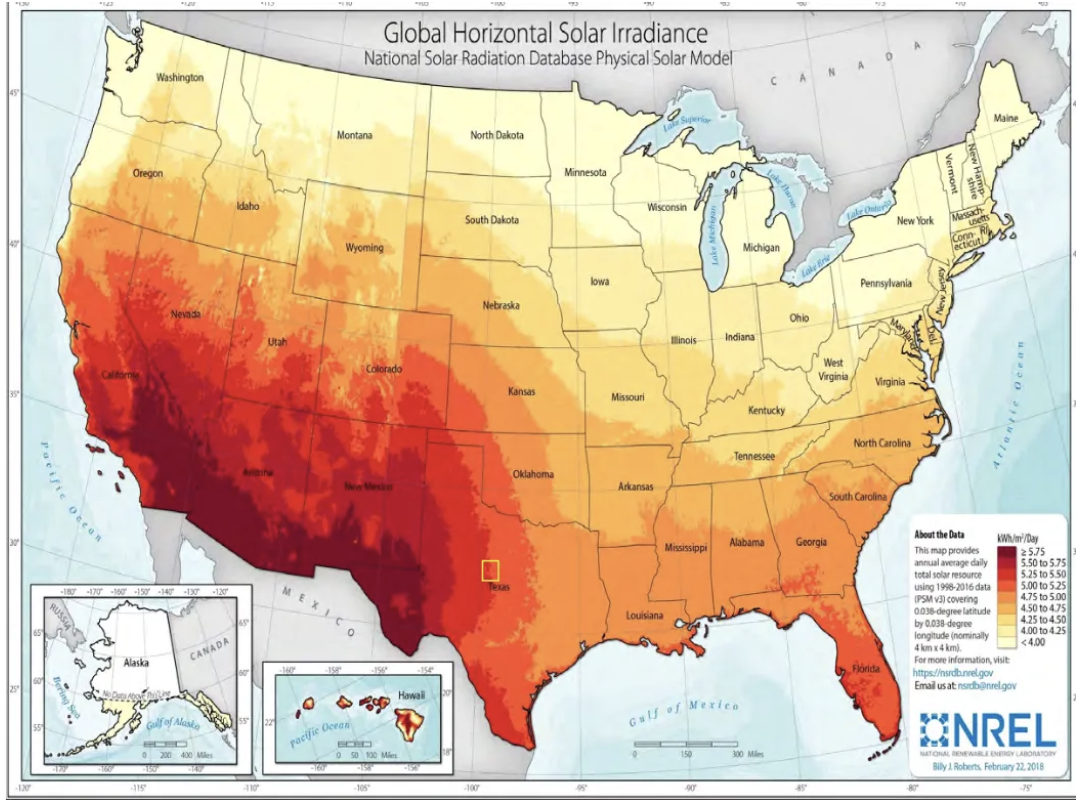
west and south texas are good places for solar- cheap land, little cloud sover
distance between earth and sun changes through the year
minimum distance at winter solstice
maximum distance at summer solstice
average earth sun distance
1.496 × 10^11 m
amount of solar radiation interception varies throughout the year
maximum on december 21st (winter solstice)
minimum on june 21st (summer solstice)
earth’s rotational axis
23.45 degrees
this tilt is the major cause of seasonal variation- solar declination causes seasons
solar declination
angle between the earth sun line (through their centers) and the plane through the equator
declination varies between -23.45 on dec. 21 and +23.45 on june 21
tropics
tropic of cancer- 23.45 N
tropic of capricorn- 23.45 S
extreme latitudes where sun is overhead at least once a year
circles
arctic circle- 66.5 degrees N
antarctic circle- 66.5 degrees S
latitudes above which sun does not rise above horizon plane at least once a year
sun in ______ in the sky in the winter and ________ in the sky in the summer
lower, higher
*big implications for solar energy generation
days are ______ in the summer
longer
position of the sun can be described by two angles
solar altitude angle- angle between line collinear with sun rays and horizontal plane
azimuth- angle between due south line and projection of the site to sun line
positive west of south and negative east of south
solar zenith angle
angle between site to sun line and vertical at the site
solar hour angle
based on nominal time of 24 hour required for sun to move 360 degrees around earth or 15 degrees per hour
morning- negative
night- positive
information about solar radiation availability
at any location essential for solar energy system
long term available for many places and in other places climatic data is sued
solar energy is in the form of EM radiation
wavelengths ranging from 0.3 micrometers to over 3 microns corresponding to UV, visble, infrared
radiation wavelengths
UV- <0.4 microns
visible- 0.4-0.7 microns
infrared- 0.-3 microns
most solar energy is concentrated in
the visible and near infrared wavelength range (VNIR)
incident solar radiation (insolation)
irradiance or energy per unit area (energy/area-time)
units for solar radiation
watts per square meter, british thermal units, langleys per minute (calorie/cm²min)
solar constant (I0)
average irradiation falling on a surface normal to the rays of the sun outside the atmosphere of the earth at a mean earth-sun distance (D0)
nominal solar constant
I0- ~1366 W/m²
TSI
total solar irradiance
how does solar radiation for earth vary over the year
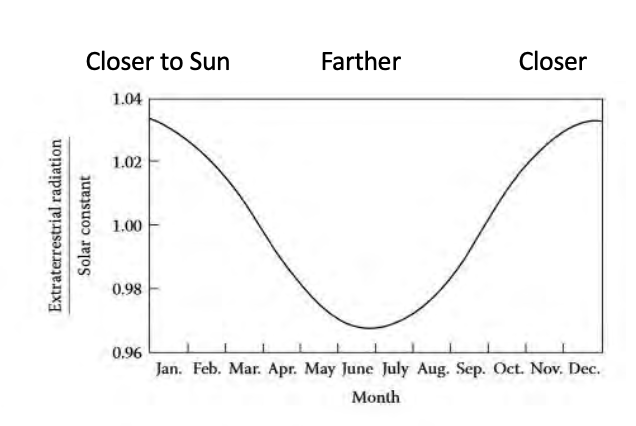
variation in seasonal solar radiation availability
can be understood from geometry of relative movement of the earth around the sun
since orbit is elliptical- earth sun distance varies- variation being ± 17% from the average
extraterrestrial solar radiation (I)
part is reflect back into space, part absorbed by air and water vapor, some scattered
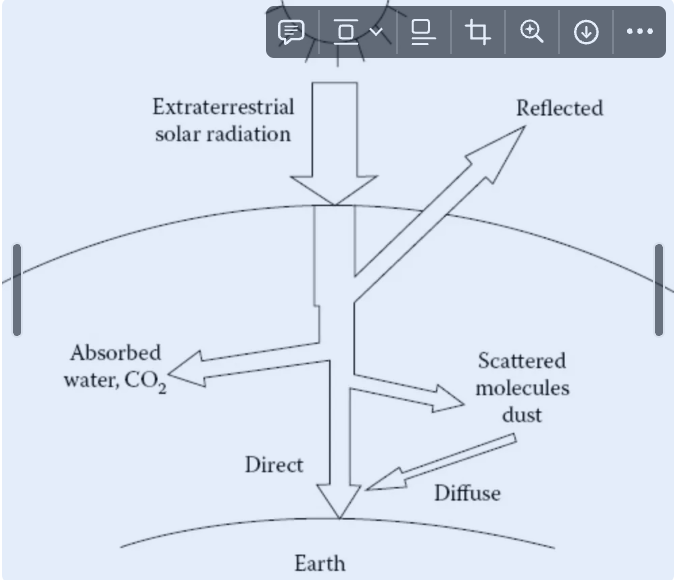
direct or beam radiation
part that reaches the earth with essentially no change in direction
sky diffuse radiation
scattered diffuse radiation reaching surface from the sky
uncertainty of radiation levels on earth
extraterrestrial radiation can be predicted with certainty, but on earth subject to uncertainty (± 30%) from local climatic interactions
so most useful solar radiation data- based on long-term (>30 years), not available for for most locations
as solar radiation travels through atmosphere
attenuated due to absorption and scattering
solar radiation on clear days
total solar radiation on horizontal surface is the sum of the beam or direct radiation and sky diffuse radiation
solar radiation output: need collector area, azimuth, collect tilt, latitude, sun rise
clearness number
C= 1 on clear days
typical meteorological year (TMY) data to determine solar radiation
used to obtain what will be insolation on a solar collector at a certain site
gives average energy yield- reference
can be used to find total insolation- sum hourly values of lc
national solar radiation database
compiled by NREL
collection of hourly and half hourly values of 3 most common measurements of solar radiation- global horizontal, direct normal, and diffuse horizontal irradiance
collected at sufficient number of locations and temporal and spatial scales to represent solar radiation climates